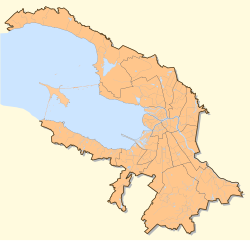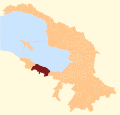Peterhof (city)
| city
Peterhof
Петергоф
|
||||||||||||||||||||||||||||||||||||
|
||||||||||||||||||||||||||||||||||||
|
||||||||||||||||||||||||||||||||||||
| List of cities in Russia | ||||||||||||||||||||||||||||||||||||
Peterhof ( Russian Петергоф / Petergof ; from 1944 to 1997 officially Petrodworez ( Петродворец )) is a medium-sized Russian town with 73,199 inhabitants (as of October 14, 2010) on the coast of the Neva Bay of the Gulf of Finland , 29 km west of the city center of Saint Petersburg . In 1998 it lost its independence and has since been part of Saint Petersburg administratively. Its urban district Petrodvorets has 128,156 inhabitants (as of October 14, 2010).
The city of Peterhof is best known for the Peterhof palace complex , which was built in 1723 and served as the summer residence of the Tsar during the Russian Empire . The entire ensemble of palace, park, pavilions and the historic old town was included in the UNESCO list of World Cultural and Natural Heritage in 1990.
history
Peterhof was founded in 1705 under Tsar Peter the Great . Initially, the village served as a location for a ferry landing stage, via which the tsar reached the island of Kotlin . Initially, the place was called Piterhof in the Dutch way , literally “Peter's court”. It was not until the 1740s that the name Peterhof (or, according to the Russian transcription rules of the time, Petergof ) became natural.
After the construction of a port in the 1710s and the tsar's palace in 1723, an independent place was created around it, which was officially granted city rights in 1762. The palace complex with the associated parks and gardens was expanded in the 18th and 19th centuries and was one of the largest of its kind at the time.
After the fall of the tsarist empire in the October Revolution , the Peterhof palaces lost their importance as a tsarist residence and were converted into a museum from 1918 onwards. During the Second World War , the city of Peterhof was on the front line of the siege of Leningrad and was badly damaged in fighting and the occupation that lasted from September 1941 to January 1944. Parts of the museum complex were also badly affected, although a large number of movable exhibits could be brought to safety in good time. The reconstruction work on the museum lasted until the 1970s.
Population development
| year | Residents |
|---|---|
| 1897 | 11,316 |
| 1939 | 44,261 |
| 1959 | 21,706 |
| 1970 | 43,136 |
| 1979 | 72,568 |
| 1989 | 81,525 |
| 2002 | 64,791 |
| 2010 | 73.199 |
Note: census data
Economy and Transport
There is hardly any industry in Peterhof today; The Petrodvorets watch factory , founded by Peter the Great in 1721 , still makes the famous Raketa watches, although with lower production compared to the Soviet era. Today the city lives mainly from tourism, most of the Peterhofers commute to work in Saint Petersburg.
In Peterhof there is a shipping pier on the Gulf of Finland.
The city has a railway connection on the Petersburg - Ust-Luga line , which runs along the southern coast of the Gulf of Finland. There are three passenger stations in the Peterhof area. The station buildings of Neu-Peterhof , built in 1857 by the French-born architect Nicholas Benois , are well worth seeing .
architecture
The Alexander Nevsky Church in Alexandriapark was built between 1831 and 1833 by Karl Friedrich Schinkel , Adam Menelaws and Josephe-Maria Charlemagne.
sons and daughters of the town
- Vladimir Kassatonov (1910-1989), Soviet admiral
- Theodor Pleske (1858–1932), zoologist
- Alexei Nikolajewitsch Romanow (1904–1918), only son of Tsar Nicholas II.
- Anastasia Michailowna Romanowa (1860–1922), Grand Duchess of Mecklenburg
- Anastasia Nikolajewna Romanowa (1901–1918), youngest daughter of Tsar Nicholas II.
- Marija Nikolajewna Romanowa (1899-1918), the second youngest daughter of Tsar Nicholas II.
- Michail Michailowitsch Romanow (1861–1929), Grand Duke
- Pawel Alexandrowitsch Romanow (1860–1919), sixth son of Tsar Alexander II.
- Boris Weinberg (1871–1942), physicist, geophysicist, glaciologist and university professor
Individual evidence
- ↑ a b c Itogi Vserossijskoj perepisi naselenija 2010 goda. Tom 1. Čislennostʹ i razmeščenie naselenija (Results of the All-Russian Census 2010. Volume 1. Number and distribution of the population). Tables 5 , pp. 12-209; 11 , pp. 312–979 (download from the website of the Federal Service for State Statistics of the Russian Federation)
Web links
- Website of the city and museum Peterhof (Russian)
- http://petergof-history.narod.ru/ (Russian)
- Peterhof on mojgorod.ru (Russian) ( Memento from September 29, 2010 in the Internet Archive )
- Peterhofer Paläste - pictures and information








